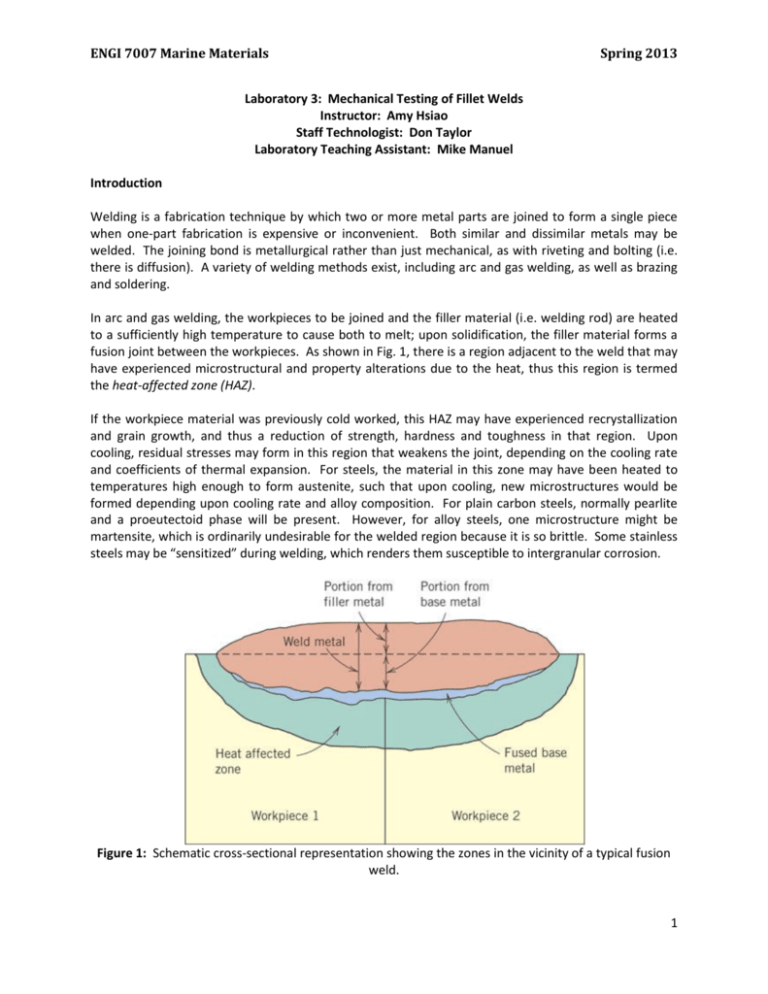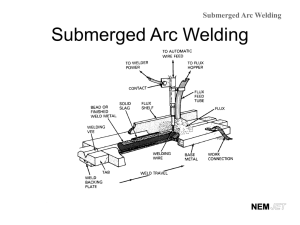
ENGI 7007 Marine Materials
Spring 2013
Laboratory 3: Mechanical Testing of Fillet Welds
Instructor: Amy Hsiao
Staff Technologist: Don Taylor
Laboratory Teaching Assistant: Mike Manuel
Introduction
Welding is a fabrication technique by which two or more metal parts are joined to form a single piece
when one-part fabrication is expensive or inconvenient. Both similar and dissimilar metals may be
welded. The joining bond is metallurgical rather than just mechanical, as with riveting and bolting (i.e.
there is diffusion). A variety of welding methods exist, including arc and gas welding, as well as brazing
and soldering.
In arc and gas welding, the workpieces to be joined and the filler material (i.e. welding rod) are heated
to a sufficiently high temperature to cause both to melt; upon solidification, the filler material forms a
fusion joint between the workpieces. As shown in Fig. 1, there is a region adjacent to the weld that may
have experienced microstructural and property alterations due to the heat, thus this region is termed
the heat-affected zone (HAZ).
If the workpiece material was previously cold worked, this HAZ may have experienced recrystallization
and grain growth, and thus a reduction of strength, hardness and toughness in that region. Upon
cooling, residual stresses may form in this region that weakens the joint, depending on the cooling rate
and coefficients of thermal expansion. For steels, the material in this zone may have been heated to
temperatures high enough to form austenite, such that upon cooling, new microstructures would be
formed depending upon cooling rate and alloy composition. For plain carbon steels, normally pearlite
and a proeutectoid phase will be present. However, for alloy steels, one microstructure might be
martensite, which is ordinarily undesirable for the welded region because it is so brittle. Some stainless
steels may be “sensitized” during welding, which renders them susceptible to intergranular corrosion.
Figure 1: Schematic cross-sectional representation showing the zones in the vicinity of a typical fusion
weld.
1
ENGI 7007 Marine Materials
Spring 2013
Tungsten Inert Gas Welding (T.I.G.) is one of the welding processes used in shipbuilding. In this TIG
process an arc is drawn between a watercooled non-consumable tungsten (W) electrode and the plate.
An inert gas shield is provided to protect the weld metal from the atmosphere, and filler metal may be
added to the weld pool as required. Ignition of the arc is obtained by means of a high frequency
discharge across the gap. The inert gas shield used for welding aluminum and steel is argon normally.
Only plate thicknesses of less than 6 mm would normally be welded by this process, and in particular
aluminum sheet, a skilled operator is required for this manual process.
Metall Inert Gas Welding (M.I.G.) is in effect an extension of TIG welding, but the electrode in this
process is a consumable metal wire. A wire feed motor supplying wire guide rollers through a contact
tube in the torch to the arc. An inert gas is supplied to the torch to shield the arc, and electrical
connections are made to the contact tube and workpiece. Welding is almost always done with a DC
source and electrode positive for regular metal transfer. This process is particularly suitable for many
applications in shipyard work for its flexibility and maneuverability.
Procedure
SAFETY is of utmost important here. Steel-toed boots and safety glasses must be worn at all times. Be
sure to note the setup, equipment, gases, and experimental procedures used in your lab notebook using
lists, sketches, or photos. Note observations throughout each stage of the lab, including specifications
(welding temperatures, gases, materials, time, loads, elongations, etc.).
In this lab you will try your hand at MIG welding two pieces of 1020 steel. You will polish and etch your
sample and observe the heat affected zone under an optical microscope. You will also perform a filletwelded joint test on your group’s best-welded sample, to check the quality of the weld up to a 200 kg-f
compressive load. Fig. 2 shows the welded sample that you will prepare and the compression test that
will be performed.
Day 1: Welding on Friday, June 28, 2:00 – 5:00 PM (Don Taylor)
Group 1 – please arrive at EN-1020 at 2:00
Group 2 – please arrive at EN-1020 at 2:30
Group 3 – please arrive at EN-1020 at 3:00
Group 4 – please arrive at EN-1020 at 3:30
Group 5 – please arrive at EN-1020 at 4:00
Group 6 – please arrive at EN-1020 at 4:30
It is recommended that the next group is waiting and ready to go 10 minutes before the scheduled time,
just in case the previous group finishes earlier.
At the end of the welding lab, pick the best-welded sample from the group, label that sample with your
group number, and hand it to Dr. Hsiao.
Day 2: Mechanical Testing on Tuesday, July 2, 2:00 – 5:00 PM (Mike Manuel and Haibing Wang)
Group 6 – please arrive at EN-1020 at 2:00
Group 5 – please arrive at EN-1020 at 2:30
Group 4 – please arrive at EN-1020 at 3:00
Group 3 – please arrive at EN-1020 at 3:30
Group 2 – please arrive at EN-1020 at 4:00
2
ENGI 7007 Marine Materials
Spring 2013
Group 1 – please arrive at EN-1020 at 4:30
A compression test will be performed on your best-welded sample and a sample provided by Tech
Services (using MIG welding also). The load will be applied at a rate of 10 mm/minute, up to a load of
200 kg-force. Observe the sample as it proceeds through elastic deformation, then plastic deformation,
by looking at the interaction of the sample and the compression plates in the Instron machine, as well
as the load-displacement data that is being collected by the accompanying software.
Save your load-displacement data on a memory stick so that you can complete the required analysis for
your laboratory report.
After mechanical testing, examine your sample with an optical microscope for evidence of cracks and
joint separations in the weld.
Figure 2: Fillet Welded Joint Test
THE WRITE-UP: A JOURNAL ARTICLE
Your write-up for this lab will be a full lab report in the form of a journal article, following the format
that includes:
Abstract
Introduction
Procedures
3
ENGI 7007 Marine Materials
Spring 2013
o Welding
o Mechanical Testing
Results and Analysis
Discussion
Conclusion
References
Please use 11-point font, 1.5-spacing formatting, either one or two columns for the text, with 1” margins
for your memorandum and figures embedded, and referred to, in the text. Remember that what makes
an excellent lab report is the organization and analysis of the information provided, as well as the use of
additional information. Please hand in all lab notebooks AND submit a hard copy and an electronic
copy of your team’s memorandum to me by Tuesday, July 16, at the beginning of class.
References
1.
Shackelford, Introduction to Materials Science for Engineers, 7th Edition, Pearson-Prentice Hall,
2009.
2.
Callister, Materials Science and Engineering: An Introduction, 8th Edition, Wiley & Sons, 2010.
4








